


I use the parameters to calculate the Φ in the final, but I don't know what happen, it shows a lot of information, but I can't understand. I am using this code to solve the problem. This code is borrowed by me. With the consent of others, then I have not changed anything, but I can't display the final result. The main problem is in the last calculation FindRoot. Follow is my code.
Hope somebody can help me, thank you very much! Cause this problem is very important to me!
(* Physical Constants *)
k = 1.38 * 10^-23;
ϵ = 8.85 * 10^-12;
e = 1.6 *10^-19;
m0 = 9.11 * 10^-31;
h = 6.63 * 10^-34;
(* Basic information of Black Phosphorus *)
κ = 6.1;
me = 0.13 * m0;
mp = 0.28 * m0;
Eg = 0.33;
Δϕ = -0.1;
(* Δϕ = ϕTip - χ *)
ΔV = 0.04;
(* ΔV = EA - EV *)
(* Experimental conditions *)
T = 4.3;
ΔS = 0.4*10^-9;
(* Distance between tip and sample *)
ni = 2/h^3*(2*π*k*T)^(3/2)*(me*mp)^(3/4)*E^(-((Eg*e)/(2*k*T)));
uB = (e*ϕB)/(k*T);
NA = 10^22;
ND = 0;
X = FindRoot[-(NA/(
1 + 4*E^(((ΔV - 1/2 Eg - ϕB)*e)/(k*T)))) ==
2*ni*Sinh[uB], {ϕB, 1/2 Eg}]
ϕB = ϕB /. X;
uB = (e*ϕB)/(k*T);
LD = ((κ*ϵ*k*T)/(2*e^2*ni))^(1/2);
Result = FindRoot[(k*T)/e*1/
LD*(NA/ni*
Log[(1 +
1/2*E^((e*ϕS)/(k*T) - ((ΔV - 1/2*Eg)*e)/(
k*T)))/(
1 + 1/2*E^((e*ϕB)/(
k*T) - ((ΔV - 1/2*Eg)*e)/(k*T)))] - 1/\!\(
\*SubsuperscriptBox[\(∫\), \(0\), \(∞\)]\(
\*FractionBox[
SuperscriptBox[\(x\),
FractionBox[\(1\), \(2\)]], \(1 +
\*SuperscriptBox[\(E\), \(x -
\*FractionBox[\(\(-Eg\)*e\), \(2*k*
T\)]\)]\)] \[DifferentialD]x\)\)*(2/3*\!\(
\*SubsuperscriptBox[\(∫\), \(0\), \(∞\)]\(
\*FractionBox[
SuperscriptBox[\(x\),
FractionBox[\(3\), \(2\)]], \(1 +
\*SuperscriptBox[\(E\), \(x -
\*FractionBox[\(\(-Eg\)*e\), \(2*k*T\)] +
\*FractionBox[\(e*ϕB\), \(k*T\)]\)]\)] \[DifferentialD]x\)\) -
2/3*\!\(
\*SubsuperscriptBox[\(∫\), \(0\), \(∞\)]\(
\*FractionBox[
SuperscriptBox[\(x\),
FractionBox[\(3\), \(2\)]], \(1 +
\*SuperscriptBox[\(E\), \(x -
\*FractionBox[\(\(-Eg\)*e\), \(2*k*T\)] +
\*FractionBox[\(e*ϕS\), \(k*T\)]\)]\)] \[DifferentialD]x\)\)) +
1/\!\(
\*SubsuperscriptBox[\(∫\), \(0\), \(∞\)]\(
\*FractionBox[
SuperscriptBox[\(x\),
FractionBox[\(1\), \(2\)]], \(1 +
\*SuperscriptBox[\(E\), \(x -
\*FractionBox[\(\(-Eg\)*e\), \(2*k*
T\)]\)]\)] \[DifferentialD]x\)\)*(2/3*\!\(
\*SubsuperscriptBox[\(∫\), \(0\), \(∞\)]\(
\*FractionBox[
SuperscriptBox[\(x\),
FractionBox[\(3\), \(2\)]], \(1 +
\*SuperscriptBox[\(E\), \(x +
\*FractionBox[\(Eg*e\), \(2*k*T\)] -
\*FractionBox[\(e*ϕS\), \(k*T\)]\)]\)] \[DifferentialD]x\)\) -
2/3*\!\(
\*SubsuperscriptBox[\(∫\), \(0\), \(∞\)]\(
\*FractionBox[
SuperscriptBox[\(x\),
FractionBox[\(3\), \(2\)]], \(1 +
\*SuperscriptBox[\(E\), \(x +
\*FractionBox[\(Eg*e\), \(2*k*T\)] -
\*FractionBox[\(e*ϕB\), \(k*T\)]\)]\)] \[DifferentialD]x\)\)))^(
1/2)*(-ΔS) == Δϕ -
1/2*Eg + ϕB - (ϕS - ϕB), {ϕS, -(1/2) Eg}]
ϕ = (ϕS /. Result[[1]]) - ϕB